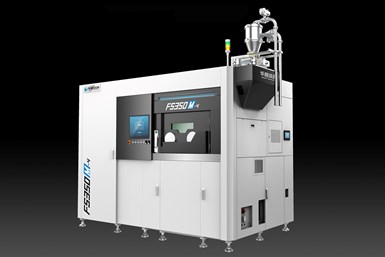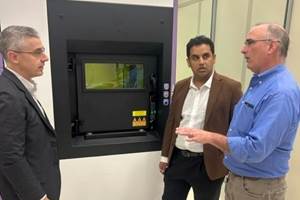Farsoon FS350M-4 Metal AM System Offers Optimal Build Efficiency, Uniform Part Performance
The system is equipped with an advanced multilaser scanning strategy and calibration algorithms which can enable optimal build efficiency and uniformed part performance throughout the build area.
Farsoon’s FS350M-4 is a medium-sized metal 3D production system offering advanced features that enable higher material efficiency and reduced cost. The system is equipped with a build envelope of 433 × 358 × 400 mm and comes standard with a quad 500-W laser configuration.
The FS350M-4 is well suited for medium- to high-volume series production of metal parts for a variety of industries, including molds, tooling, automotive and aerospace. The current material capability of powder materials includes aluminum, titanium, maraging steels and specialized grades of stainless steels.
Equipped with advanced multilaser scanning strategy and calibration algorithms, the systems offers optimal build efficiency, and uniformed part performance throughout the build area. Because of the latest process parameters development — including variable layer thickness, adaptive scanning strategies for infill and detail — the FS350M-4 is able to achieve improved productivity along with excellent part quality. For example, with a shoe mold application, the platform is capable of producing over 95% of all shoe sizes of one pair of shoe molds in a single build, with 60% higher build volume rates compared to other metal LPBF systems in its class.
The metal system includes design features that can reduce the manufacturing cost per part. In large-scale additive manufacturing (AM) production operations, the inert gas consumption is a large portion of the cost. The FS350M-4 limits that expense with its efficient inert gas system as the purge process takes only 11 minutes. During the printing process, the inert gas consumption requires only 3-5 L/min, which the company says is significantly lower than the industry average.
The platform is equipped with an integrated, advanced 3-stage filter module, featuring a back-flush function to ensure longer filter life which helps reduce the cost of the filter changes. In addition, the company says a permanent filter solution will also be available in the near future which will further enhance machine uptime and ease of operations. The closed-loop Powder Management System, intelligent recoating control and advanced layered gas flow design enable higher material efficiency and reduced cost.
The compact system has a machine footprint of 6 m2 with an integrated filtration system. In an AM factory setting, the FS350M-4 enables a high-density layout to achieve maximum throughput per floor area for utilizing a more efficient production layout.
The FS350M-4 also has a high-efficiency top-feed powder system. Once the powder level in the container runs low, the equipped sensor will release a message for refill. The powder refill unit can be easily docked, enabling quick refill of the material without disturbing the build process.
- Read about the Farsoon Flight 403P dual-laser platform which offers high-temperature plastic LPBF. The 403P Series offers a versatile, powerful platform for plastic laser sintering that can achieve two full industrial-scale builds (cylinder size 400 × 400 × 540 mm) within 24 hours.
- Learn about Farsoon’s FS1521M which has 16 lasers for large-format metal additive manufacturing. The FS1521M metal 3D printing platform series offers advanced multilaser scanning strategies with optional modes for efficiency, quality or balanced performance for different manufacturing needs.
Related Content
Video: How Multimaterial Laser Powder Bed Fusion Works
Penn State University’s CIMP-3D is exploring applications of the Schaeffler Aerosint system for multimaterial 3D printing. During a recent visit, I got an introduction to this system.
Read MoreNew Zeda Additive Manufacturing Factory in Ohio Will Serve Medical, Military and Aerospace Production
Site providing laser powder bed fusion as well as machining and other postprocessing will open in late 2023, and will employ over 100. Chief technology officer Greg Morris sees economic and personnel advantages of serving different markets from a single AM facility.
Read MoreTwo 12-Laser AM Machines at Collins Aerospace: Here Is How They Are Being Used
With this additive manufacturing capacity, one room of the Collins Iowa facility performs the work previously requiring a supply chain. Production yield will nearly double, and lead times will be more than 80% shorter.
Read MoreDMG MORI: Build Plate “Pucks” Cut Postprocessing Time by 80%
For spinal implants and other small 3D printed parts made through laser powder bed fusion, separate clampable units resting within the build plate provide for easy transfer to a CNC lathe.
Read MoreRead Next
Crushable Lattices: The Lightweight Structures That Will Protect an Interplanetary Payload
NASA uses laser powder bed fusion plus chemical etching to create the lattice forms engineered to keep Mars rocks safe during a crash landing on Earth.
Read MorePostprocessing Steps and Costs for Metal 3D Printing
When your metal part is done 3D printing, you just pull it out of the machine and start using it, right? Not exactly.
Read MoreBike Manufacturer Uses Additive Manufacturing to Create Lighter, More Complex, Customized Parts
Titanium bike frame manufacturer Hanglun Technology mixes precision casting with 3D printing to create bikes that offer increased speed and reduced turbulence during long-distance rides, offering a smoother, faster and more efficient cycling experience.
Read More





















